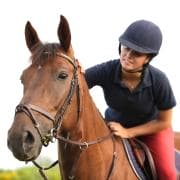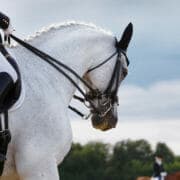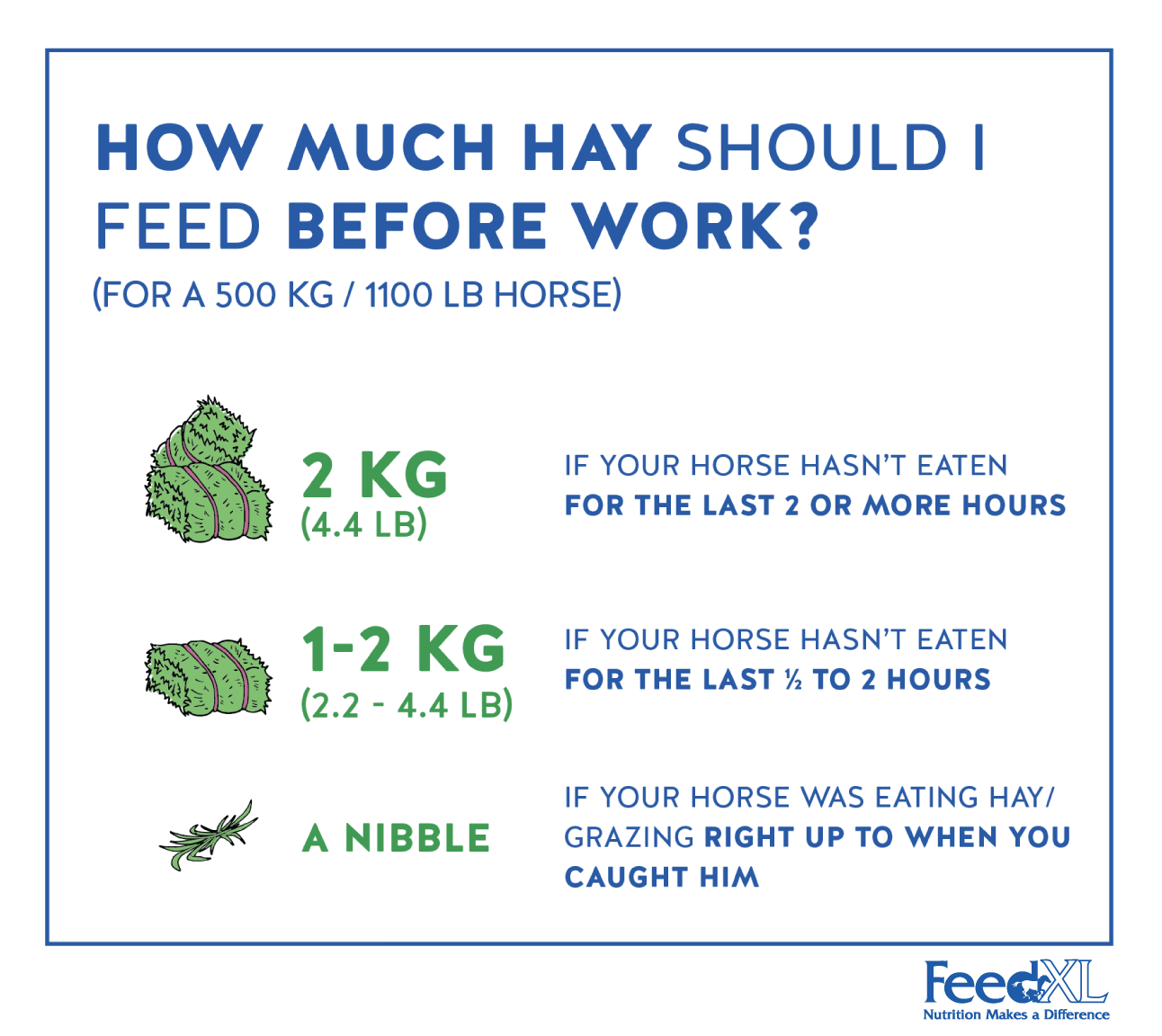Feeding Your Horse After Exercise
When horses exercise, they burn up stored energy supplies, damaging muscle tissue and losing water and electrolytes via sweat. Feeding after exercise is important to replenish these energy, water and electrolyte stores and provide protein for muscle repair. Failure to do so can result in reduced performance, muscle wastage and slow recovery times. What you feed, how you feed it and when it is fed all play a role in determining how effectively you replace what your horse uses during moderate to high intensity exercise and how quickly they will recover.
Replenish energy reserves
When a horse exercises, its muscles use glycogen (glucose that is stored by the muscles), fatty acids and some amino acids as fuel. During fast sprint type, high intensity work, muscles operate under anaerobic (no oxygen) conditions and primarily use glycogen as an energy source. Under slower, low to moderate, intensity work the muscles will primarily burn fatty acids for energy under aerobic (oxygen using) conditions, saving muscle glycogen supplies for when it is needed for high intensity work.
If muscle glycogen supplies are depleted, the horse quickly becomes fatigued. Therefore, it is important that after exercise, muscle glycogen supplies are replenished, otherwise the next time the horse exercises it will start with less glycogen on board and will reach a state of fatigue faster.
 The fastest way to replenish glycogen supplies in equine athletes is to feed a grain‐based meal following exercise. Grains contain starch, which is digested and absorbed as glucose and this glucose is directly used to replenish glycogen supplies. The grains fed should be cooked (either extruded, micronised, steam flaked or boiled) to maximise their small intestinal digestibility (so more of the starch can be digested and absorbed as glucose).
The fastest way to replenish glycogen supplies in equine athletes is to feed a grain‐based meal following exercise. Grains contain starch, which is digested and absorbed as glucose and this glucose is directly used to replenish glycogen supplies. The grains fed should be cooked (either extruded, micronised, steam flaked or boiled) to maximise their small intestinal digestibility (so more of the starch can be digested and absorbed as glucose).
A grain‐based meal should be fed within an hour of completing exercise. Once the horse has returned to a near normal respiration rate and started to cool down the meal can be fed. If the horse has completed its exercise for the day, it can be fed its normal morning or evening feed at this time. If you are still taking part in competition (for example you are at a vet check point in an endurance ride) you should limit the meal to 200 g of grain per 100 kg of bodyweight (or 0.2 lb per 100 lb of bodyweight) so that you don’t induce a large increase in blood insulin levels (as discussed in our blog: Feeding Horses Before Exercise).
The horse’s normal ration of hay and/or pasture should also be made available immediately following exercise. If your horse cannot have grain in its diet or does not have grain as part of its normal daily ration you must not use grain to replenish glycogen supplies following exercise. Instead, these horses should just receive their normal non‐grain ration. It may take these horses longer to recover from very heavy exercise and as such they may not be capable of sustaining the workloads required for intense sports like horseracing, endurance and polo.
A note about overweight and lightly worked horses
If your horse is overweight or lightly worked, it isn’t necessary to replace glycogen supplies following work. The focus for overweight horses should be to burn calories and lose weight. Following exercise, their body will gradually replace any muscle glycogen that was burnt during exercise using other sources of energy like propionate, a volatile fatty acid absorbed from their hindgut that can be turned into glucose. Feeding grain after exercise will only serve to slow weight loss progress and may even cause weight gain. Overweight horses are also unlikely to exercise at an intensity that uses up any significant amount of glycogen.
Likewise, it is unnecessary to replenish glycogen supplies by feeding a grain meal following exercise in horses that are only lightly worked or horses that are only worked a couple of times a week. These horses are unlikely to burn much glycogen and/or they have plenty of time to easily replace what they did use before their next bout of exercise.
Look after the muscles
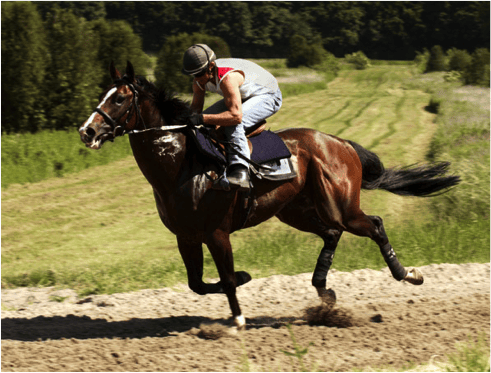
During exercise a horse’s muscles experience multiple little rips and tears that have to be repaired. The muscles also need to grow, strengthen and tone so they can cope with the work required of them. Ensuring crude protein and lysine requirements are met according to FeedXL will mean your horse’s muscles have access to plenty of amino acids to repair and grow, however supplying high quality protein in the form of whey protein concentrate immediately following work (within the first 15 minutes of finishing exercise) may help lightly muscled horses build muscle bulk faster.
Whey protein provides rapidly absorbed amino acids that first feed a horse’s muscles, second signal to them to slow or stop the muscle breakdown process that occurs during and following exercise and finally, provides muscles with the building blocks they need to grow and strengthen.
Dose rates of 10 to 20 grams per 100 kg of bodyweight of whey protein concentrate are commonly used. There are also equine specific whey protein and other high protein supplements available for this purpose. Timing is critical for these supplements to be effective; it must be given immediately after exercise (as opposed to giving it with the next meal).
Rehydrate
There has been much debate over the years about when to allow a hot horse to drink water following exercise, with the common perception being that allowing a hot horse to drink causes colic. While you may wrestle with whether to let your horse drink immediately following exercise, I would urge you to use your common sense and knowledge of your own horse. If your horse wants to drink following exercise and doesn’t seem to suffer any ill effects, then I would suggest allowing him to drink, as the positive effects of rehydration will be far greater than the benefits associated with not allowing a horse to drink until it is completely cooled. Drinking water will also help to lower a horse’s core body temperature following exercise.
You should observe a few guidelines:
- Offer cool water that is at a temperature that is comfortable for you to hold your hand in (i.e. not too cold).
- If you horse is a real guzzler, get him to take a few small breaks when drinking.
If you have observed your horse get colicky after a big drink, then it would be wise to allow access to water gradually after exercise. But if your horse drinks with no ill effects, there is no reason to withhold water following exercise.
Research has also shown that giving slightly salty water (which you can make by adding up to 9 grams of sodium chloride, which is common table salt, per litre to your horse’s water) as the first water your horse has access to, followed by giving access to plain water aids in achieving high fluid intakes and faster rates of rehydration.
Replace electrolytes
When horses sweat, they lose large amounts of the electrolyte minerals sodium, chloride and potassium. They also lose smaller amounts of magnesium and calcium. These minerals lost in sweat must be replaced to allow full rehydration and normal sweating and muscle function in subsequent bouts of exercise.
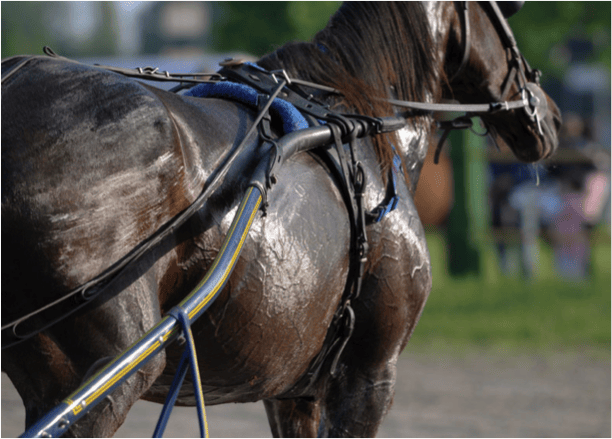
Ensuring that your horse’s requirements for sodium, potassium and chloride are met according to FeedXL and making sure your horse has free access to a salt lick is adequate to ensure electrolyte repletion on a daily basis. Under intense workloads (for example endurance) or when horses are working in very hot and humid conditions you may need to consider using a specially designed electrolyte replacer for horses.
When selecting an electrolyte replacer for your horse, read the label of the available electrolyte supplements carefully. Be wary of products that contain less than 800 grams per kg of actual electrolytes (sodium, potassium, chloride, calcium and magnesium). Some products on the market are more than 50% ‘filler’ (usually dextrose or glucose) which is of little benefit to the horse as part of an electrolyte replacement program. Some glucose is necessary for the effective absorption of sodium, but glucose should represent no more than 10% of an electrolyte supplement.
The use of electrolyte replacers is a large and relatively complex topic that deserves a dedicated FeedXL newsletter.
Summary
Failure to replace what a fit horse in moderate to high intensity work uses during a bout of exercise will mean that the horse gradually becomes less and less able to complete the work required of it. Using a digestible cooked grain-based feed in the first hour following the completion of exercise will restore muscle glycogen supplies. Feeding a high-quality protein supplement like a whey protein concentrate within 15 minutes of the completion of exercise will feed the muscles and allow them to repair and strengthen. Providing access to water, and initially slightly salty water following exercise will allow your horse to rehydrate itself. And finally, ensuring dietary requirements for the electrolyte minerals sodium, chloride and potassium are met according to FeedXL will allow your horse to replenish electrolyte minerals lost during exercise as it eats its normal daily ration.
Join FeedXL today and take control of your horse’s nutrition
Get EVEN MORE practical and personalised feeding guidance when you sign up to FEEDXL.
Do you have a question or comment? Do you need help with feeding?
We would love to welcome you to our FeedXL Horse Nutrition Facebook Group. Ask questions and have them answered by PhD and Masters qualified equine nutritionists and spend time with like-minded horse owners. It’s free!
Click here to join the FeedXL Horse Nutrition Facebook Group

